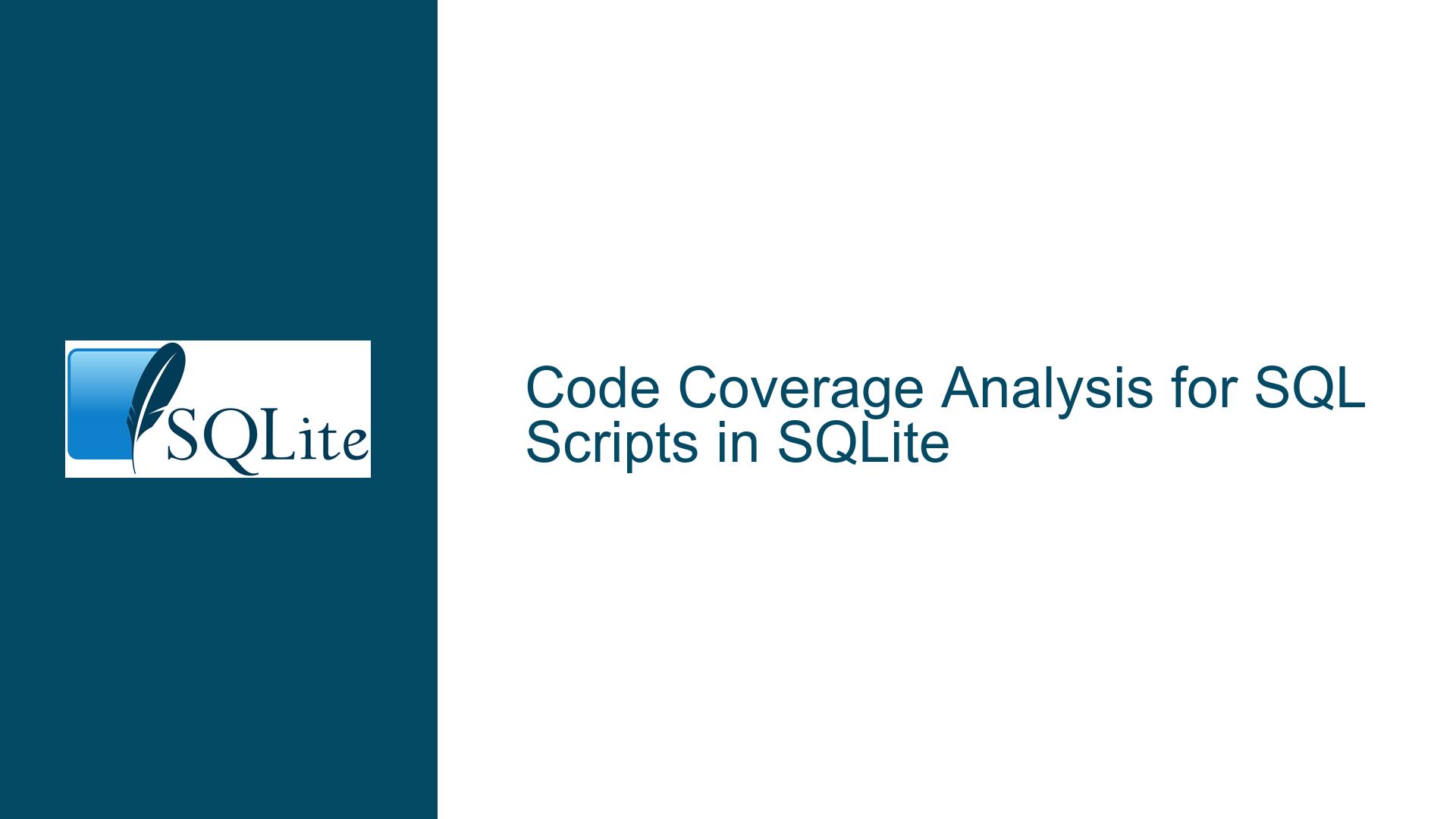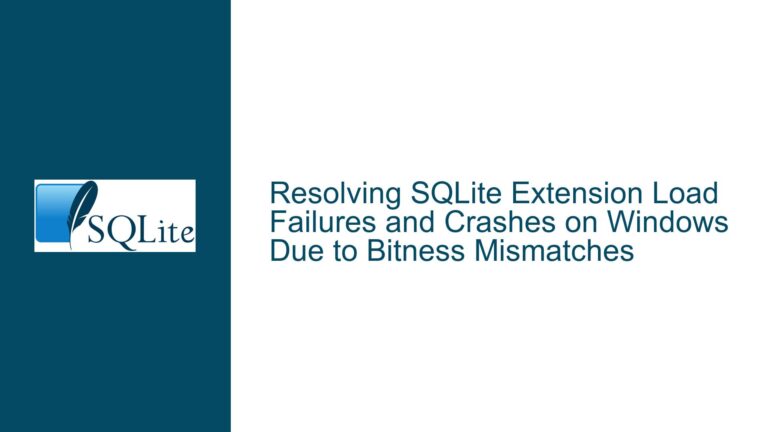Code Coverage Analysis for SQL Scripts in SQLite
Understanding Code Coverage for SQL Scripts in SQLite
Code coverage is a critical metric in software development that measures the extent to which the source code of a program is executed during testing. It helps developers identify untested parts of their codebase, ensuring that all logical paths are validated. While code coverage tools are widely available for traditional programming languages like Python, Java, or C++, the landscape is less mature for SQL scripts, particularly in SQLite. SQL scripts often include table creation, data manipulation, and query logic, all of which need to be tested to ensure correctness and robustness.
In SQLite, SQL scripts are typically used to define schema structures (e.g., CREATE TABLE, CREATE INDEX), insert or update data (e.g., INSERT, UPDATE), and perform complex queries (e.g., SELECT with JOIN, WHERE, and GROUP BY). Ensuring that these scripts are thoroughly tested requires a combination of unit tests, integration tests, and tools that can track which parts of the SQL code are executed during testing. However, SQLite does not natively provide a built-in code coverage tool, which leaves developers to rely on external tools or custom solutions.
The challenge lies in tracking the execution of SQL statements and determining whether they are covered by existing tests. For example, if a CREATE TABLE statement is executed but never populated with data or queried in the tests, it may indicate a gap in test coverage. Similarly, complex filtering logic in WHERE clauses or joins in SELECT statements may not be fully exercised if the test data is insufficient or the test cases are incomplete.
To address this, developers often need to combine SQLite’s tracing capabilities with custom tooling or leverage third-party tools that can instrument SQL execution and generate coverage reports. This process requires a deep understanding of SQLite’s internals, as well as the ability to parse and analyze SQL scripts and their execution traces.
Challenges in Measuring SQL Script Coverage
Measuring code coverage for SQL scripts in SQLite presents several unique challenges. Unlike traditional programming languages, SQL is declarative, meaning that the logic is expressed in terms of what needs to be done rather than how to do it. This makes it difficult to instrument SQL statements in the same way that procedural or object-oriented code can be instrumented.
One major challenge is the lack of granularity in SQL execution tracing. SQLite’s TRACE API provides low-level information about SQL statement execution, but it does not inherently track which specific parts of a statement (e.g., individual clauses or expressions) are executed. For example, if a SELECT statement includes a WHERE clause with multiple conditions, the TRACE API will only indicate that the statement was executed, not which conditions were evaluated or how often.
Another challenge is the dynamic nature of SQL scripts. SQL statements are often constructed dynamically at runtime based on application logic, making it difficult to statically analyze the code for coverage. For instance, a query might include a WHERE clause that varies depending on user input or application state. This dynamic behavior complicates the task of determining whether all possible paths through the SQL logic have been tested.
Additionally, SQLite’s lightweight and embedded nature means that it lacks some of the advanced profiling and debugging features found in larger database systems. While SQLite provides tools like the EXPLAIN command and the sqlite3_trace_v2 function, these are not designed for comprehensive code coverage analysis. Developers must therefore build custom solutions or adapt existing tools to meet their needs.
Finally, the integration of SQL script coverage into a broader testing framework can be challenging. SQL scripts are often tightly coupled with application code, and their execution depends on the state of the database and the application. This means that coverage analysis must be performed in the context of the entire application, rather than in isolation. This requires careful coordination between database testing and application testing, as well as the ability to generate meaningful coverage reports that can be interpreted by developers.
Strategies for Implementing SQL Script Coverage
To implement code coverage for SQL scripts in SQLite, developers can adopt a combination of strategies that leverage SQLite’s built-in features, custom tooling, and third-party solutions. The goal is to track the execution of SQL statements and their components, identify gaps in test coverage, and generate actionable insights for improving test quality.
One approach is to use SQLite’s TRACE API to log SQL statement execution. The sqlite3_trace_v2 function allows developers to register a callback that is invoked whenever a SQL statement is executed. By analyzing these logs, developers can determine which statements were executed during testing and identify any statements that were not covered. However, this approach requires significant effort to parse and interpret the logs, as well as to correlate them with the original SQL scripts.
Another strategy is to instrument SQL scripts with custom markers or annotations that indicate which parts of the script should be tracked for coverage. For example, developers could insert comments or special tokens into the SQL code that are recognized by a coverage tool. The tool would then monitor the execution of these marked sections and generate a coverage report. This approach provides more granularity than the TRACE API but requires modifications to the SQL scripts and the development of a custom coverage tool.
A third option is to use a third-party tool or library that provides SQL script coverage analysis. While there are few tools specifically designed for SQLite, some general-purpose database testing tools can be adapted for this purpose. These tools typically work by intercepting SQL statements as they are executed, analyzing their structure, and tracking their execution paths. The resulting coverage data can then be visualized in a report or integrated into a continuous integration pipeline.
Regardless of the approach, it is important to establish a clear testing strategy that defines what constitutes adequate coverage for SQL scripts. This includes identifying critical paths, edge cases, and potential failure points in the SQL logic. Developers should also consider the impact of database state on test coverage, as the same SQL statement may behave differently depending on the data in the database.
In addition to technical solutions, developers should adopt best practices for writing testable SQL scripts. This includes breaking down complex scripts into smaller, modular components that can be tested independently. It also involves using consistent naming conventions, avoiding hard-coded values, and documenting the expected behavior of each script. By following these practices, developers can make it easier to measure and improve code coverage for their SQL scripts.
Conclusion
Measuring code coverage for SQL scripts in SQLite is a complex but essential task for ensuring the reliability and maintainability of database-driven applications. While SQLite does not provide native support for code coverage analysis, developers can use a combination of built-in features, custom tooling, and third-party solutions to achieve this goal. By understanding the challenges and adopting effective strategies, developers can gain valuable insights into the quality of their SQL scripts and identify areas for improvement in their testing processes.
The key to success lies in a thorough understanding of SQLite’s capabilities, a clear testing strategy, and a commitment to best practices in SQL script development. With the right tools and techniques, developers can ensure that their SQL scripts are thoroughly tested and that their applications are built on a solid foundation of reliable database logic.






